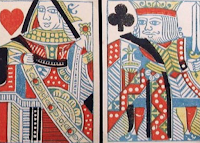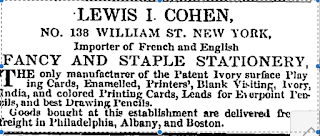I’ve been doing talks around the country on immigration history, weaving in video clips from my interviews with Jewish elders. The interviews and history combined with artwork are part of my book We Spoke Jewish:A Legacy in Stories. This article explores that history with a few genealogy tips.
The United States is a nation built on immigration, yet the reality is our history has often been decidedly unfriendly to the immigrant. As immigration has once again become a topic of much debate, it is useful to revisit our nation’s history to better understand the past and inform the present.
For the early part of our history we really didn’t have much in the way of immigration requirements. If you’ve ever looked at a manifest from the 1800s, you will find few details. In 1812 the ship captain was required to keep a manifest with the name, age, sex, occupation and country of those entering the US.
After the Civil War the Supreme Court found that immigration was a responsibility of the federal government. The government obliged in 1882 with the first immigration law, The Chinese Exclusion Act. This law banned those of Chinese ethnicity, trapping many young Chinese men in bachelor communities in the United States. They were unable to return to China for a temporary visit to family and unable to bring a wife to the United States. Most had come here during the Gold Rush and had moved from mining to building the railroad.
 As fate would have it, an "act of God" offered them a respite with the 1906 earthquake which destroyed San Francisco birth records. This allowed them to claim US birth as no one could prove otherwise. A thriving business in paper sons began where sons were claimed by these new citizens and the papers sold to others who wished to come to the US. They assumed the new name and identity to do so.
As fate would have it, an "act of God" offered them a respite with the 1906 earthquake which destroyed San Francisco birth records. This allowed them to claim US birth as no one could prove otherwise. A thriving business in paper sons began where sons were claimed by these new citizens and the papers sold to others who wished to come to the US. They assumed the new name and identity to do so.
Having cut their teeth on this law, the government issued a spate of laws to restrain immigrants from entering our shores. In 1882 we blocked idiots, lunatics and convicts. Still greater impact came from restrictions on those deemed to be a likely public charge. This was frequently applied to women and children traveling alone. If a male didn’t show up to take responsibility they could be sent back.
If they were detained, you will see an X to the left of the name. At the end of the manifest, you will find a listing of detained aliens and who, if anyone, picked them up. You can gauge the number of days they were held by the number of meals they were fed.
In 1892 Ellis Island opened and the Immigration Service took over management of manifests. By 1906, the manifests were expanded to two pages and now identified the town of origin rather than the country. They also tell you who the nearest relative was in Europe and who they were going to in the United States, useful information to work back to family in Europe.
Restrictions continued in 1907 with a ban on persons with physical or mental defects, tuberculosis and children traveling without a parent. They would however let children remain if a parent picked them up. In my family there is a mystery child who came with my grandmother’s sibling, claimed my great-grandfather as her father and promptly disappeared. No doubt she was a cousin or friend aware that under this law she ran the risk of being sent back if not claimed.
In 1917 virtually all Asians were banned, and we expanded physical and mental defects to include homosexuality, not to be removed until 1990.
The naturalization documents paralleled that of the immigration manifest, sketchy at first, more extensive after 1906. The naturalization document offers an important source for name changes, noting the current name and the name under which they entered the country if different. It also provides the names, ages and place of birth of the applicant and his family. Citizenship for a wife followed the husband with her naturalization accompanying his. Similarly, her loss of citizenship also followed. If a natural-born female citizen married a non-naturalized male, she lost her citizenship. It was not until 1922 that citizenship was dealt with on an individual basis.

Despite the laws cited, immigrants continued to flood the US. Between 1900 and 1920, 14 million immigrants entered the country, 13% of the population. In the first quarter of the century, over 1.75 million Jews came to America. This number was dwarfed however by the 3 million Italians who came between 1900 and 1915. This was a time of racial prejudice, a belief in eugenics and high unemployment (“They’re taking our jobs!”). The Russian revolution had ignited the first Red Scare and nativism and xenophobia were at a peak. All of these were factors behind the Immigration Act of 1924, an effort to turn back the clock. In fact, the law sought to make time stand still by putting a quota system in place based on the percent of each group in the 1890 census. This advantaged the British, Germans and Irish who made up 70% of the early population and severely limited the number of Jews and Italians at whom it was aimed. The national origins system remained in place until 1965.
A visa was now required to enter the United States, and this included an extensive packet of information: a photo, birth certificate, certificate that they were free of trachoma and character certificate. In a bow to eugenics one must have never been in a prison or hospital for the insane and one's parents must never have been treated for insanity. This information can now be ordered from the US Citizenship and Immigration Service.
The Jews that entered the country during this period frequently lived and worked in an insular geographic area. Antisemitism often played a role in this, limiting where they could live and work. Virtually everyone in their community spoke Yiddish and old-world customs were common.
The next wave of Jewish immigrants came after WWII, survivors of the Holocaust. Antisemitism in the State Department and Congress restricted the response of the United States to save Jews during the war. A 1939 proposal to admit 20,000 Jewish children, similar to the Kindertransport, was defeated in Congress with opposition from 60% from the public. The ship, the Saint Louis, with over 900 German Jews, was turned away with many sent to their death. The US had visa capacity for German Jews but dispersed only 30% of the German quota during the war.
For three years after the war there was no legislation to allow refugees entrance and by the time it occurred, most had gone to Israel. Truman was frustrated by this inaction and took an executive action in 1945 to apply any remaining visa capacity to these refugees. This brought in 15,000 Jewish refugees, most who had family in the US.
The larger question of legislation was finally addressed in 1948 allowing 200,000 refugees of which 80,000 were Jewish. Jewish leaders purposely sought to widen the scope to all refugees, certain that something directed at Jews would not pass. In fact, in 1948, 53% of the public favored admitting displaced persons, but 60% favored placing restrictions if most of them were Jews. Legislation favored agricultural workers, a slant that Truman called flagrantly discriminatory against Jews.
This was the time of the Red Scare and the Rosenberg trial when 21% of Americans believed most Jews were Communists. Two thirds of those questioned by McCarthy’s Senate committee in 1952 were Jewish. Upon immigrating, survivors were queried about Communist involvement.
After the war, legislation focused upon subversive acts and security. Quotas were updated from 1890 levels to 1920 levels and that 1924 law was finally eliminated in 1965 as we refocused on skills and family reunification.
Most of the Jews from the former Soviet Union, came in under the Refugee Act of 1980, a law we see in action still today. This law deals with overseas refugees and asylum seekers. Many went via a circuitous route with Israel as the purported destination, then sought political refugee status in transit to come to the US. There in accordance with a 1952 law, they were interviewed by consular staff and it was determined if they were refugees.
They came to the US in hopes of leaving the virulent antisemitism of the Soviet Union behind. One of my interviewees described her US experience in contrast to that of Russia:
We’re Russian but we’re not. We’re from Russia, but we’ve never been Russian. We’ve always been Jews. Jews here and Jews there. But here we’re Americans, American Jew. Over there we were just Jew. Period.
Although Jews are well integrated into the America experience, our immigrant past is not distant. For many of us it influences values and encourages empathy, reminding us that we were once “them.”
 As I work with collage, I think of my mother. She became a collage artist late in life as she lost memory. She had been an avid reader and could no longer retain the thread of a story. Loss created a space that she sought to fill with new purpose and meaning. I consider whether loss well-used is really a gift. We just need to recognize it as such.
As I work with collage, I think of my mother. She became a collage artist late in life as she lost memory. She had been an avid reader and could no longer retain the thread of a story. Loss created a space that she sought to fill with new purpose and meaning. I consider whether loss well-used is really a gift. We just need to recognize it as such.























